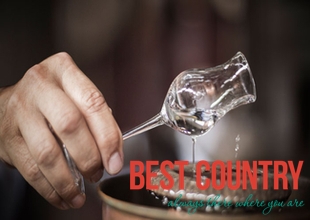Singani Bolivia: the country's national drink

Invented in the mid-sixteenth century, singani was originally created to satisfy the demands of the wealthy residents of Potosí, a mining outpost that was at one time the richest city on Earth. The residents were looking for a cheap way to replace orujo (another type of brandy imported from Spain) and the wine producers of the region created singani as an alternative. Its name is an Aymara phrase which means “a place where sedge grows,” sedge being a special type of plant found in Andean valleys where they are protected from weather extremes. Many places in Bolivia bear this name and it is unknown which specific one gave birth to the namesake liquor.
Singani belongs to the brandy family, which means that it is produced by distilling wine to create a potent, high-alcohol spirit. Although there are many such liquors across the world, the wine used to make singani is special because of its specific terroir (the natural environment where the wine is produced). Producers use only one specific varietal of grape, the white Muscat of Alexandria, an ancient vine originally cultivated in Egypt but brought over to the Americas by Spanish colonists during the 1500s. Owing to the topography of the Andes, these grapes are only grown at altitudes of more than 5,000 feet. Since the air at this altitude can be cold even when the sun’s rays are reaching the crop, the grapes have developed an especially thick skin to protect themselves from the elements. This exceptionally thick skin, being the part of the grape where much of the flavor is contained, is what gives singani its uniquely rich aroma and taste. High-elevation distillation also changes the boiling point.
Though they may seem very similar at first glance, singani has a distinctive flavor which is markedly different from pisco and other grape brandies. Due to the high-altitude along with the specific production methods incorporated by producers, singani has a much more intense and complex flavor than most pisco, which is produced at sea-level. For this reason, singani is best enjoyed simply with ice and a slice of lime.
If drinking pure liquor on-the-rocks is not your preferred way to imbibe, there are also a number of delicious cocktails containing singani. Stay tuned for our next blog, which will feature a list of traditional singani cocktails to try in Bolivia.
However you choose to drink it, a taste of singani is absolutely essential to any trip to Bolivia. Don’t forget to visit a quality bar in La Paz or elsewhere in Bolivia to try it for yourself.
Quick Tip: Experience the thrill of biking the Bolivia Death Road, one of the most dangerous roads in the world! Enjoy amazing scenery as you descend from high-altitude mountains to jungle landscapes.
Tip: If you’re in La Paz, the best way to get to Copacabana or to points in Peru is by visiting the Bolivia Hop website and booking a ticket. Bolivia Hop is a hop on hop off style bus service which allows you to travel in Bolivia safely and at your own pace. The bus picks you up directly from your hostel and brings you to your next destination. And if you decide that you love a certain place and want to stay some extra time? No problem at all, just catch the next bus! This service is highly recommended.